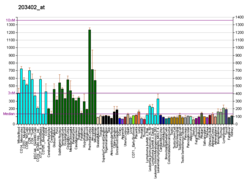Voltage-gated potassium channel subunit beta-2 is a protein that in humans is encoded by the KCNAB2 gene.[5][6]
Function
[edit]Voltage-gated potassium (Kv) channels represent the most complex class of voltage-gated ion channels from both functional and structural standpoints. Their diverse functions include regulating neurotransmitter release, heart rate, insulin secretion, neuronal excitability, epithelial electrolyte transport, smooth muscle contraction, and cell volume. Four sequence-related potassium channel genes - shaker, shaw, shab, and shal - have been identified in Drosophila, and each has been shown to have human homolog(s). This gene encodes a member of the potassium channel, voltage-gated, shaker-related subfamily. This member is one of the beta subunits, which are auxiliary proteins associating with functional Kv-alpha subunits. This member alters functional properties of the KCNA4 gene product. Alternative splicing of this gene results in two transcript variants encoding distinct isoforms.[6]
In melanocytic cells KCNAB2 gene expression may be regulated by MITF.[7]
Interactions
[edit]KCNAB2 has been shown to interact with KCNA2.[8][9]
See also
[edit]References
[edit]- ^ a b c GRCh38: Ensembl release 89: ENSG00000069424 – Ensembl, May 2017
- ^ a b c GRCm38: Ensembl release 89: ENSMUSG00000028931 – Ensembl, May 2017
- ^ "Human PubMed Reference:". National Center for Biotechnology Information, U.S. National Library of Medicine.
- ^ "Mouse PubMed Reference:". National Center for Biotechnology Information, U.S. National Library of Medicine.
- ^ Schultz D, Litt M, Smith L, Thayer M, McCormack K (Mar 1997). "Localization of two potassium channel beta subunit genes, KCNA1B and KCNA2B". Genomics. 31 (3): 389–91. doi:10.1006/geno.1996.0065. PMID 8838324.
- ^ a b "Entrez Gene: KCNAB2 potassium voltage-gated channel, shaker-related subfamily, beta member 2".
- ^ Hoek KS, Schlegel NC, Eichhoff OM, Widmer DS, Praetorius C, Einarsson SO, Valgeirsdottir S, Bergsteinsdottir K, Schepsky A, Dummer R, Steingrimsson E (2008). "Novel MITF targets identified using a two-step DNA microarray strategy". Pigment Cell Melanoma Res. 21 (6): 665–76. doi:10.1111/j.1755-148X.2008.00505.x. PMID 19067971.
- ^ Coleman SK, Newcombe J, Pryke J, Dolly JO (Aug 1999). "Subunit composition of Kv1 channels in human CNS". J. Neurochem. 73 (2): 849–58. doi:10.1046/j.1471-4159.1999.0730849.x. PMID 10428084.
- ^ Nakahira K, Shi G, Rhodes KJ, Trimmer JS (Mar 1996). "Selective interaction of voltage-gated K+ channel beta-subunits with alpha-subunits". J. Biol. Chem. 271 (12): 7084–9. doi:10.1074/jbc.271.12.7084. PMID 8636142.
Further reading
[edit]- McCormack K, McCormack T, Tanouye M, Rudy B, Stühmer W (1995). "Alternative splicing of the human Shaker K+ channel beta 1 gene and functional expression of the beta 2 gene product". FEBS Lett. 370 (1–2): 32–6. Bibcode:1995FEBSL.370...32M. doi:10.1016/0014-5793(95)00785-8. PMID 7649300.
- McCormack T, McCormack K (1995). "Shaker K+ channel beta subunits belong to an NAD(P)H-dependent oxidoreductase superfamily". Cell. 79 (7): 1133–5. doi:10.1016/0092-8674(94)90004-3. PMID 8001150. S2CID 10080280.
- Nakahira K, Shi G, Rhodes KJ, Trimmer JS (1996). "Selective interaction of voltage-gated K+ channel beta-subunits with alpha-subunits". J. Biol. Chem. 271 (12): 7084–9. doi:10.1074/jbc.271.12.7084. PMID 8636142.
- Kääb S, Dixon J, Duc J, Ashen D, Näbauer M, Beuckelmann DJ, Steinbeck G, McKinnon D, Tomaselli GF (1998). "Molecular basis of transient outward potassium current downregulation in human heart failure: a decrease in Kv4.3 mRNA correlates with a reduction in current density". Circulation. 98 (14): 1383–93. doi:10.1161/01.cir.98.14.1383. PMID 9760292.
- Coleman SK, Newcombe J, Pryke J, Dolly JO (1999). "Subunit composition of Kv1 channels in human CNS". J. Neurochem. 73 (2): 849–58. doi:10.1046/j.1471-4159.1999.0730849.x. PMID 10428084.
- Poliak S, Gollan L, Martinez R, Custer A, Einheber S, Salzer JL, Trimmer JS, Shrager P, Peles E (2000). "Caspr2, a new member of the neurexin superfamily, is localized at the juxtaparanodes of myelinated axons and associates with K+ channels". Neuron. 24 (4): 1037–47. doi:10.1016/S0896-6273(00)81049-1. PMID 10624965. S2CID 12444497.
- Croci C, Brändstatter JH, Enz R (2003). "ZIP3, a new splice variant of the PKC-zeta-interacting protein family, binds to GABAC receptors, PKC-zeta, and Kv beta 2". J. Biol. Chem. 278 (8): 6128–35. doi:10.1074/jbc.M205162200. PMID 12431995.
- Gu C, Jan YN, Jan LY (2003). "A conserved domain in axonal targeting of Kv1 (Shaker) voltage-gated potassium channels". Science. 301 (5633): 646–9. Bibcode:2003Sci...301..646G. doi:10.1126/science.1086998. PMID 12893943. S2CID 9924760.
- Rush J, Moritz A, Lee KA, Guo A, Goss VL, Spek EJ, Zhang H, Zha XM, Polakiewicz RD, Comb MJ (2005). "Immunoaffinity profiling of tyrosine phosphorylation in cancer cells". Nat. Biotechnol. 23 (1): 94–101. doi:10.1038/nbt1046. PMID 15592455. S2CID 7200157.
- Lim J, Hao T, Shaw C, Patel AJ, Szabó G, Rual JF, Fisk CJ, Li N, Smolyar A, Hill DE, Barabási AL, Vidal M, Zoghbi HY (2006). "A protein-protein interaction network for human inherited ataxias and disorders of Purkinje cell degeneration". Cell. 125 (4): 801–14. doi:10.1016/j.cell.2006.03.032. PMID 16713569. S2CID 13709685.
External links
[edit]- KCNAB2+protein,+human at the U.S. National Library of Medicine Medical Subject Headings (MeSH)
This article incorporates text from the United States National Library of Medicine, which is in the public domain.










